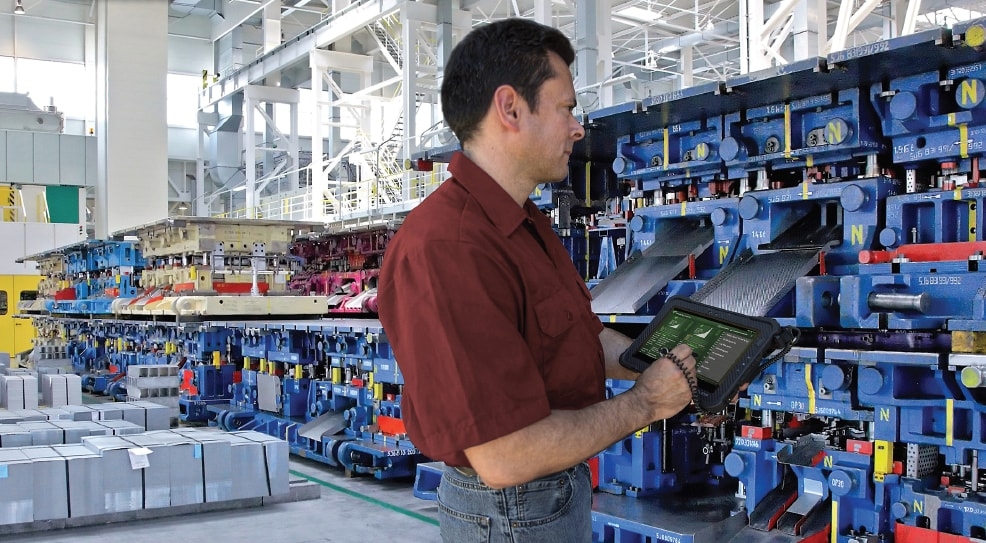
Assessing rugged mobile computing needs in Industry 4.0 smart factories
April 10, 2018
By John Graff

Apr. 10, 2018 – The Industry 4.0 movement is completely up-ending manufacturing as we know it, and advanced mobile solutions, robotics, artificial intelligence, sophisticated sensors and the Internet of Things (IoT) are all playing a role in ushering in this next industrial revolution. According to VDC Research, the demand for mobile solutions that are more intuitive and easier to learn is a key pressure for warehouse environments undergoing mobility transformations.
The study notes that the only way the smart factory vision can be achieved is to implement mobile technology, which will then allow manufacturers to digitalize paper processes, improve communications, and provide full visibility into the complete flow of operations. While operating this smart factory may be a manufacturer’s dream, currently only 44 per cent of factory floors support shop floor control through the use of mobile devices. The majority of facilities still manage everyday tasks via paper-based processes — leading to inefficiencies, human error and redundancies. That is why manufacturers need to first focus on creating paperless factories.
However, it’s not enough to ditch paper for just any data-processing device. Corporate computers are too fragile to be used in a manufacturing environment and typically aren’t located close enough to the plant floor for real-time database input. And, it’s a well-known fact in the manufacturing industry that non-ruggedized devices will never meet the high-quality design standards required both inside and outside the four walls. These features include damage-resistant screens, industrial strength frames, and shock- and vibration-resistant solid-state drives (SSDs).
That’s why rugged tablets and detachable 2-in-1 laptops are becoming pervasive beyond just supervisors and other employees who walk and work. The highly mobile form factors are now preferred over fixed terminal PCs on forklifts. There’s a misperception that forklift-mounted computers are immune from the common drop hazards given their more stationary nature. Yet, they are still at the mercy of human handling — including the ink pens, screwdrivers or other tools that workers tend to keep in hand and improperly use to interact with touchscreens. Forklift computers are also subjected to constant temperature changes that occur during picking and putaway in cold storage facilities, hot loading docks and high humidity environments.
In other words, industrial operations demand indestructible mobile devices that can survive any daily hazard without fail, and can be easily removed from service should maintenance be required, without forcing a forklift or worker to go offline. Fast, reliable and highly scalable mobile computers are also mandatory for manufacturers who require widespread distribution of accurate, real-time information in order to maintain precision operations; as production demands increase, logistics become more complex and delivery timelines tighten.
For these reasons, many manufacturers are fast-tracking investments in what they’re told are easy to deploy, easy to manage, all-in-one single vendor mobility bundles that are prepackaged with “highly compatible” hardware, software, accessory and security components.
Steps for success
Bundled solutions fail to meet high performance, low-cost paperless factory expectations and will prevent you from scaling to smarter technologies. The devices included in these bundles are not built to last very long and offer limited compatibility with legacy peripherals and more advanced technology platforms such as IoT, sensors and wearables, if compatible at all.
To ensure today’s mobility investments will remain viable in a truly automated and smart factory environment:
1. Enlist the help of manufacturing mobility experts, not just mobile technology providers. They will help you formulate a best-in-class Industry 4.0-ready mobility solution based on a rugged mobile computing platform that addresses your specific business challenges, aligns with your business goals, and easily integrates with your IT architecture. They will also help you identify which workflows to mobilize to improve business processes so that you don’t waste time and money on solutions that will never solve anything.
2. Develop an architecture foundation that includes hardware, software, security and performance requirements. Then, examine digital assets to ensure they are delivering the right information, at the right time, to the right device. Remember: No two rugged tablets, laptops or handhelds are the same. The ratings you see on paper only tell you so much about the quality, performance and lifecycle reliability of mobile computers. Find the operating system (OS) and feature set that best support your specialized workflows and smart factory operations, just as you would look for specialized production line equipment. Don’t be quick to dismiss Android; recent advancements in security, MDM and overall OS flexibility have made it a very
viable enterprise-grade computing option for factories, warehouses and distribution centres.
3. Calculate the TCO and ROI of your mobile technology options. Calculators can help you determine a more accurate figure – beyond the hard costs – and secure executive buy-in for your mobility project. It will prove just how significant an impact rugged mobile computing solutions can have on operational efficiency and, therefore, stability and profitability in volatile markets.
John Graff is the vice president of marketing for Xplore Technologies.
This article was originally published in the March/April 2018 issue of Manufacturing AUTOMATION.
Advertisement
- Steam Whistle’s $22.8M expansion to create 100 new jobs
- New Brampton facility will assemble light rail vehicles